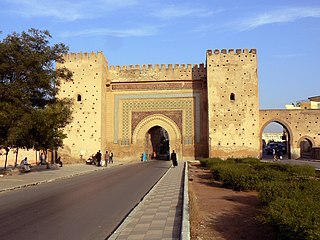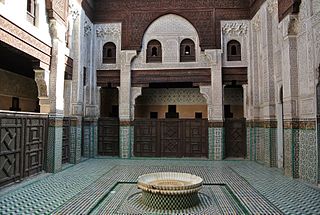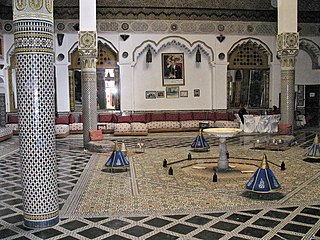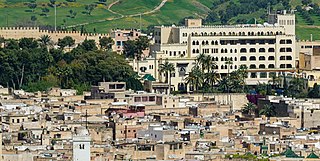
Meknes is one of the four Imperial cities of Morocco, located in northern central Morocco and the sixth largest city by population in the kingdom. Founded in the 11th century by the Almoravids as a military settlement, Meknes became the capital of Morocco during the reign of Sultan Moulay Ismaïl (1672–1727), son of the founder of the Alaouite dynasty. Moulay Ismaïl created a massive imperial palace complex and endowed the city with extensive fortifications and monumental gates. The city recorded a population of 632,079 in the 2014 Moroccan census. It is the seat of Meknès Prefecture and an important economic hub in the region of Fès-Meknès.

Moroccan architecture reflects Morocco's diverse geography and long history, marked by successive waves of settlers through both migration and military conquest. This architectural heritage includes ancient Roman sites, historic Islamic architecture, local vernacular architecture, 20th-century French colonial architecture, and modern architecture.

The Museum of Marrakech is a historic palace and museum located in the old center of Marrakesh, Morocco. In addition to its notable architecture, the museum's collection showcases various historic art objects and contemporary art from Morocco.

Fes el Bali is the oldest walled part of Fez, the second largest city of Morocco. Fes el Bali was founded as the capital of the Idrisid dynasty between 789 and 808 AD. UNESCO listed Fes el Bali, along with Fes Jdid, as a World Heritage Site in 1981 under the name Medina of Fez. The World Heritage Site includes Fes el Bali's urban fabric and walls as well as a buffer zone outside of the walls that is intended to preserve the visual integrity of the location. Fes el Bali is, along with Fes Jdid and the French-created Ville Nouvelle or “New Town”, one of the three main districts in Fez.

The Bou Inania Madrasa is a historic madrasa in the city of Meknes, Morocco. The building, well-preserved thanks to later restorations, is considered an excellent example of the richly-decorated madrasas of the Marinid period.

The Zawiya of Moulay Idris II is a zawiya in Fez, Morocco. It contains the tomb of Idris II, who ruled Morocco from 807 to 828 and is considered the main founder of the city of Fez. It is located in the heart of Fes el-Bali, the UNESCO-listed old medina of Fez, and is considered one of the holiest shrines in Morocco. The current building experienced a major reconstruction under Moulay Ismail in the early 18th century which gave the sanctuary its overall current form, including the minaret and the mausoleum chamber with its large pyramidal roof.

Dar Batḥa, or Qasr al-Batḥa, is a former royal palace in the city of Fez, Morocco. The palace was commissioned by the Alaouite Sultan Hassan I in the late 19th century and finished under his successor Abdelaziz. It was converted into a museum of historical arts and crafts in 1915 with a collection that now comprises over 6,500 objects. The palace is located near Bab Bou Jeloud at the western edge of Fes el-Bali, the old medina quarter of the city, and close to Fes el-Jdid, the new medina quarter. It is adjacent to the Dar el-Beida palace located to its southeast, which was originally part of the same complex.

The R'cif Mosque is a Friday mosque in Fes el-Bali, the old city (medina) of Fez, Morocco. It has one of the tallest minarets in the city and overlooks Place R'cif in the heart of the medina.

The architecture of Fez, Morocco, reflects the wider trends of Moroccan architecture dating from the city's foundation in the late 8th century and up to modern times. The old city (medina) of Fes, consisting of Fes el-Bali and Fes el-Jdid, is notable for being an exceptionally well-preserved medieval North African city and is classified as a UNESCO World Heritage Site. A large number of historic monuments from different periods still exist in it today, including mosques, madrasas, synagogues, hammams (bathhouses), souqs (markets), funduqs (caravanserais), defensive walls, city gates, historic houses, and palaces.

Dar el Bacha is a palace located in the old medina of Marrakesh, Morocco. It currently houses the Museum of Confluences.

The Grand Mosque of Meknes is the historic main mosque of the old city (medina) of Meknes, Morocco. It is the largest and most important mosque in the old city and one of its oldest monuments.

The Lalla Aouda Mosque or Mosque of Lalla 'Awda is a large historic mosque in Meknes, Morocco. It was originally the mosque of the Marinid kasbah (citadel) of the city, built in 1276, but was subsequently remodeled into the royal mosque of the Alaouite sultan Moulay Isma'il's imperial palace in the late 17th century.

The Mnebhi Palace or Menebhi Palace, also known by its French name Palais Mnebhi, is a historic early 20th-century palace in Fes el-Bali, the old medina of Fes, Morocco. It is notable for both its lavish architecture as well as for being the place where the 1912 Treaty of Fes was officially signed. It is located on Tala'a Seghira street, one of the main souq streets of the city.

Dar Moqri is a historic palace or group of mansions in Fes el-Bali, the old medina of Fes, Morocco. It dates from the late 19th and early 20th centuries and was built by the wealthy and powerful Moqri family. The site is occupied by two grand residences built separately by members of the same family but physically adjoining each other. The older palace was begun by Abdelsalam al-Moqri and probably further modified by his son Muhammad. In addition to its rich interior, it is notable for its large terraced garden. The second palace belonged to his grandson Si Tayb and is notable for its long courtyard which mixes Italianate details with traditional Moroccan decoration. A completely separate palace, known as Riad Driss Moqri, was also built further north by Abdelsalam's son, Si Dris.

The Jamai Palace, also known as the Dar Jama'i or the Palais Jamaï, is a historic late 19th-century mansion near Bab Guissa in Fes el-Bali in Fes, Morocco. It was converted to a luxury hotel in 1919, which closed in 2014.

The Kasbah of Moulay Ismail is a vast palace complex and royal kasbah (citadel) built by the Moroccan sultan Moulay Isma'il ibn Sharif in Meknes, Morocco. It is also known, among other names, as the Imperial City or Palaceof Moulay Ismail, or the Kasbah of Meknes. It was built by Moulay Isma'il over the many decades of his reign between 1672 and 1727, when he made Meknes the capital of Morocco, and received occasional additions under later sultans.

The Dar Jamai Museum is a museum in Meknes, Morocco. It displays a number of artifacts and art objects from the city and other regions in Morocco. It is housed in a late 19th-century palace built by the Jama'i family who also built the Jamai Palace in Fes.

The Mausoleum of Moulay Isma'il is a historic Islamic funerary complex in Meknes, Morocco. It contains the tomb of Sultan Moulay Isma'il, who ruled Morocco from 1672 until his death in 1727, and is located inside his former Kasbah (citadel). It is a major historic and religious site in the city.

Dar Ba Mohammed Chergui, also known as Dar al-Aman, is a historic palace or riad-style mansion in the old medina of Fez, Morocco. It is located on Derb el Horra street in Fes el-Bali.

Traditional houses in Morocco are usually centered around a large internal courtyard, the wast ad-dar, and are characterized by a focus on interior decoration rather than on external appearance. The houses of wealthy residents featured decoration typical of Moroccan architecture and medieval Moorish architecture, including carved and painted wood, carved stucco, and zellij. The center of larger houses could also be occupied by a riad garden, particularly in places like Marrakesh where more space was available.


























